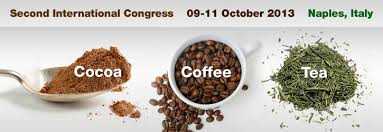Scherbl D.1, Erk T.1, Barron D.2, Dionisi F.2; Hauser, J.1, Muentnich S.1, Renouf M.2; Steiling H.2, Williamson G.2, Richling E.1 1 Department of Food Chemistry and Toxicology, Molecular Nutrition, University of Kaiserslautern, Kaiserslautern, Germany 2 Nestlé Research Center, Vers-Chez-les-Blanc, Lausanne, Switzerland E-mail: scherbl@chemie.uni-kl.de Chlorogenic acids (CGAs) from coffee are antioxidants and have potential to reduce the risk of diabetes. Their positive effect on human health is dependent on their bioavailability.
Up to now, few data on structure- or dose- dependent relationships on absorption of CGAs have been published. We performed an in vivo study, where intestinal availability of CGAs was investigated in ileostomy volunteers.
After a polyphenol-free diet, ileostomists consumed instant coffee with various CGA contents (1053, 2219 and 4525 μmol) [1, 2] to investigate the dose- response. Ileal fluids, urine and plasma were collected and CGA concentrations were determined.
Additionally, in vitro and ex vivo absorption experiments using Caco-2 cells and pig jejunal mucosa respectively were conducted in the Ussing chamber model (simulating apical/basolateral compartments of mucosa in a dynamic system) to confirm the in vivo observations.
Polyphenols from coffee, caffeoylquinic acid (CQA), feruloylquinic acid (FQA), caffeic acid (CA), dicaffeoylquinic acid (diCQA), D-(−)-quinic acid (QA), and caffeoylquinic acid lactones (CQL) were added in physiologically concentrations to the apical compartment of the chamber (0.1– 3.5 mM). Samples were analyzed by HPLC-DAD and HPLC-ESI-MS/MS.
In the in vivo study, 78% of the ingested CQAs from instant coffee were excreted via the ileostomy bags. It was shown that the consumption of higher CGA concentrations lead to a faster ileal excretion.
In addition, a proportionally lower amount of the ingested CGA dose was metabolized or hydrolyzed with higher ingested dose, which could conceivably be due to enzyme saturation, limitation of substrates, limited transport capacities at the enterocyte or an influence of the gastrointestinal transit time.
In agreement with the literature, we also identified sulfation as the major phase II conjugation reaction in the upper GIT, but we additionally observed an increasing proportion of glucuronidation with increasing CGA dose.
The proportions of CGA metabolites in urine were not affected by dose, whereas the ratios of sulfation:glucuronidation in urine showed a dose dependency similar to ileal fluid. Our results using pig jejuna mucosa indicated a structure-dependent absorption, resulting in higher absorption of the free acids as compared to the respective esters which is in line our in vivo findings. Additionally, no differences were observed within the CGA subgroups. The CQA and CQL-isomers showed comparable absorption efficiencies.
The concentration-dependent absorption kinetics of the more hydrophobic CQL as well as their precursor 5-CQA showed a non-saturable absorption and a linear dose-flux relationship up to 1 mM indicating a passive diffusion process. Overall, the results of these studies allow the conclusion that active efflux plays a significant role in CGAs bioavailability, and that absorption in the jejunum is governed by their physico chemical properties. Additionally, the consumption of high concentrations of CGAs affects intestinal bioavailability of polyphenols and therefore systemic availability as well.
These studies were supported by Nestlé Research Center (NRC, Lausanne, Switzerland). [1] Erk, T. et al. Absorption and isomerization of caffeoylquinic acids from different foods using ileostomist volunteers. Eur J Nutr. 2013, DOI 10.1007/s00394-013-0512-z [Epub ahead of print] [2] Erk, T. et al. Dose-dependent absorption of chlorogenic acids in the small intestine assessed by coffee consumption in ileostomists. Mol Nutr Food Res. 2012, 56, 1488–1500


















